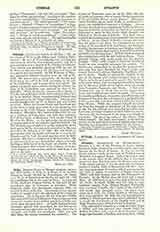

Otranto, Archdiocese of (HYDRUNTINA) Otranto is a city of the Province of Lecce, Apulia, Southern Italy, situated in a fertile region, and once famous for its breed of horses. It was an ancient Greek colony, which, in the wars of Pyrrhus and of Hannibal, was against Rome. As it is the nearest port to the eastern coast of the Adriatic Sea, it was more important than Brindisi, under the Roman emperors. In the eighth century, it was for some time in the possession of Arichis, Duke of Benevento (758-87). Having come again under Byzantine rule, it was among the last cities of Apulia to surrender to Robert Guiscard (1068), and then became part of the Principality of Taranto. In the middle Ages the Jews had a school there. In 1480 there occurred the sack of Otranto by the Turks, in which 12,000 men are said to have perished—among them, Bishop Stephen Pendinelli, who was sawn to death; the “valley of the martyrs” still recalls that dreadful event. On other occasions, as in 1537, the Turks landed at Otranto, but they were repulsed. In 1804, the city was obliged to harbor a French garrison that was established there to watch the movements of the English fleet; and in 1810, Napoleon gave Otranto in fief to Fouché.
The cathedral of Otranto is a work of Count Roger I (1088), and was adorned later (about 1163), by Bishop Jonathas, with a mosaic floor; the same Count Roger also founded a Basilian monastery here, which, under Abbot Nicetas, became a place of study; its library was nearly all bought by Bessarion. The first known bishop of this see was Petrus, to whom St. Gregory the Great refers in 596; and there is record of his two successors; they were Sabinus (599) and Petrus (601); Bishop Marcus (about 870) is believed to be the author of the office for Holy Saturday; Petrus (958) was raised to the dignity of metropolitan by Polyeuctus, Patriarch of Constantinople (956-70), with the obligation to establish the Greek Rite throughout the province. The Latin Rite was introduced again after the Norman conquest, but the Greek Rite remained in use in several towns of the archdiocese and of its suffragans, until the sixteenth century. Bishop Jacob IV (1378), also Patriarch of Jerusalem, had a part in the schism of the West, for which reason he was imprisoned by Charles of Anjou, and compelled to abjure publicly; after that, however, he betook himself to Avignon; Peter Anthony of Capua (1536) distinguished himself at the Council of Trent; Francis M. dall’Aste (1596) was author of “Memorabilia Hydruntinae Ecclesiae”.
In 1818 Castro, formerly a suffragan of Otranto, was united to it. Castro’s bishops are known from 1137; among them was John Parisi, killed in 1296 by Canon Hector, of Otranto.
The suffragans of Otranto are Gallipoli, Lecce, and Ugento; the archdiocese has 56 parishes, 100,200 inhabitants, 4 religious houses of men, 11 of women, 2 schools for boys, and 9 for girls.
U. BENIGNI

